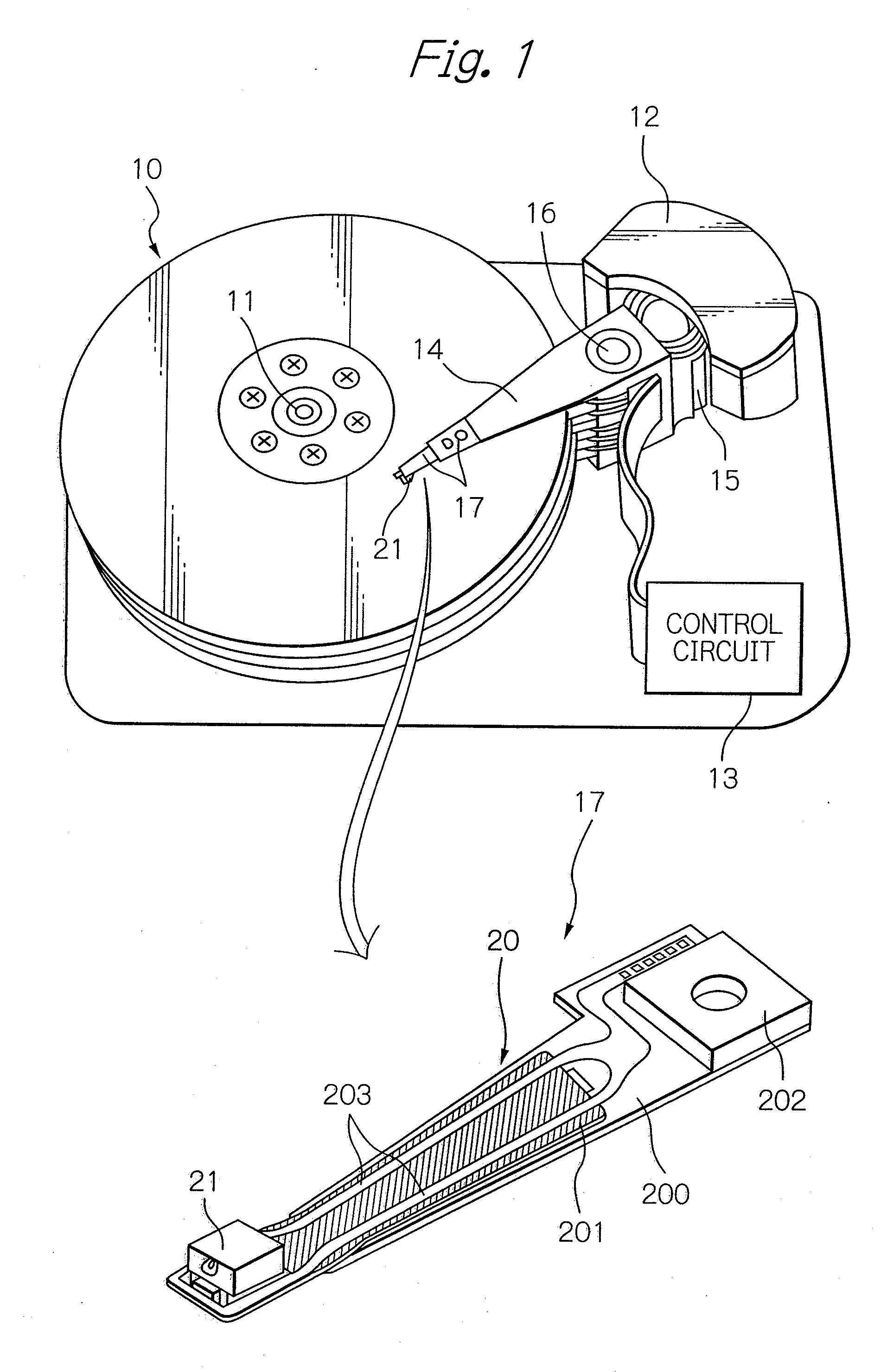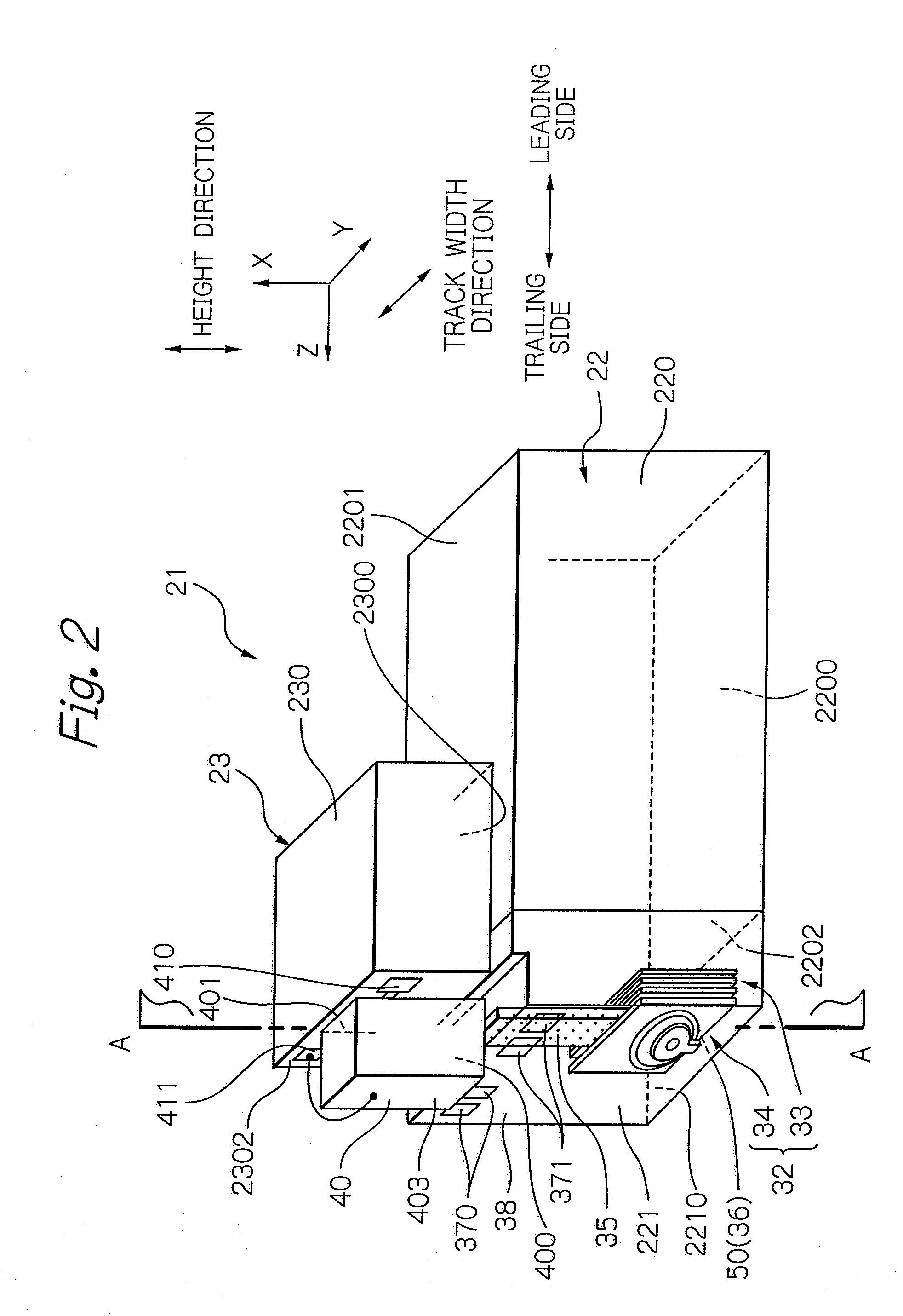[0010]Accordingly, it is an object of the present invention to provide a method for forming a near-field light generating element, which is capable of sufficiently suppressing the unevenness of a waveguide surface and the
distortion within the waveguide, and to provide a near-field light generating element in which unevenness of a waveguide surface and distortion within the waveguide is sufficiently suppressed to reduce a
light propagation loss. Another object of the present invention is to provide a near-field light generating element in which light propagating through a waveguide can be properly irradiated on a plasmon antenna. A further object of the present invention is to provide a thermally-assisted magnetic
recording head provided with the near-field light generating element, to provide a head
gimbal assembly (HGA) provided with the head, and further to provide a magnetic recording apparatus provided with the HGA.
[0018]In the method for forming the near-field light generating element, by providing the first and second etching stopper
layers, over-etching can be prevented even when each etching process takes enough etch time, which allows easy management of etching endpoints. As a result, a large step (depth difference) does not be formed. Thereafter, an upper waveguide layer is further stacked, and there can be sufficiently suppressed the unevenness of a surface, particularly of an upper surface, of the formed waveguide. Further, the distortion within the waveguide is sufficiently suppressed, which can reduce the propagation loss of the
laser light propagating through the waveguide. Moreover, in other head element part, for example, a main magnetic pole layer of a write head element, which is formed over the waveguide, there can be avoided the unevenness and the distortion caused by using the waveguide as an undercoat.
[0020]Further in the embodiment of providing the additional etching stopper layer, it is preferable that, after the formation of the second side surface, an etching is applied to
expose potions of the additional etching stopper layer, the portions positioned other than directly below the plasmon-antenna material layer. Furthermore, it is preferable that the forming method further comprises: forming an upper waveguide layer made of material for forming the waveguide, so as to cover the plasmon antenna material layer on which the first side surface and the second side surface are formed; planarizing an upper surface of the formed upper waveguide layer, with use of
polishing; and forming a height regulating
mask having a predetermined width in a height direction, on the upper surface of the planarized upper waveguide layer, and forming, with use of etching, the plasmon antenna having a predetermined height and portions of the waveguide covering the plasmon antenna. Here, the step (depth difference), which existed before being covered with the upper waveguide layer, has been suppressed to be small, and can be easily eliminated or reduced by the planarization. As a result, there can be sufficiently suppressed the unevenness of the formed waveguide surface and the distortion within the waveguide, which can reduce the propagation loss of the
laser light. Moreover, in other head element part, for example, a main magnetic pole layer of a write head element, which is formed over the waveguide, there can be avoided the unevenness and the distortion caused by using the waveguide as an undercoat.
[0021]Further, it is preferable that a
refractive index of the lower waveguide layer and the upper waveguide layer is set to a value between each of
refractive index values of the first etching stopper layer and the second etching stopper layer, and a
refractive index value of the additional etching stopper layer. Further, in this case, it is more preferable that an overall refractive index of a multilayer that comprises the first etching stopper layer, the additional etching stopper layer and the second etching stopper layer, is set to a value substantially equal to the refractive index of the lower waveguide layer and the upper waveguide layer. Furthermore, it is also preferable that each of the refractive indexes of the first etching stopper layer and the second etching stopper layer is set to be larger than the refractive index of the lower waveguide layer and the upper waveguide layer, and the refractive index of the additional etching stopper layer is set to be smaller than the refractive index of the lower waveguide layer and the upper waveguide layer. The setting of these refractive indexes enables the plasmon antenna to effectively be irradiated with the light propagating through the waveguide.
[0022]Further, in the above-described method for forming a near-field light generating element, it is also preferable that the first etching stopper layer and the second etching stopper layer are formed of
tantalum oxide, the additional etching stopper layer is formed of
alumina, the plasmon antenna material layer is formed of one element selected from a group of Au, Ag, Al, Cu, Pd, Pt, Rh and Ir, or an
alloy composed of at least two elements selected from the group, and the lower waveguide layer and the upper waveguide layer are formed of
silicon oxy-
nitride, and further each of the etching for forming the first side surface and the second side surface is an
ion milling with use of
mixed gas of
nitrogen and
argon,
nitrogen gas, or gas including
nitrogen. This setting enables each etching during
forming processes to be performed appropriately due to the achievement of the above-described setting of refractive indexes.
[0025]In the above-described near-field light generating element, by employing the above-described configuration of the stopper multilayer and the plasmon antenna, there can be sufficiently suppressed the unevenness of the surface, particularly of the upper surface, of the waveguide and the distortion within the waveguide, which can reduce the propagation loss of the light propagating through the waveguide. Moreover, it is possible to effectively direct the propagating light to the plasmon antenna in the waveguide. Furthermore, in other head element part, for example, a main magnetic pole layer of a write head element, which is formed over the waveguide, there can be avoided the unevenness and the distortion caused by using the waveguide as an undercoat.
 Login to View More
Login to View More  Login to View More
Login to View More 


